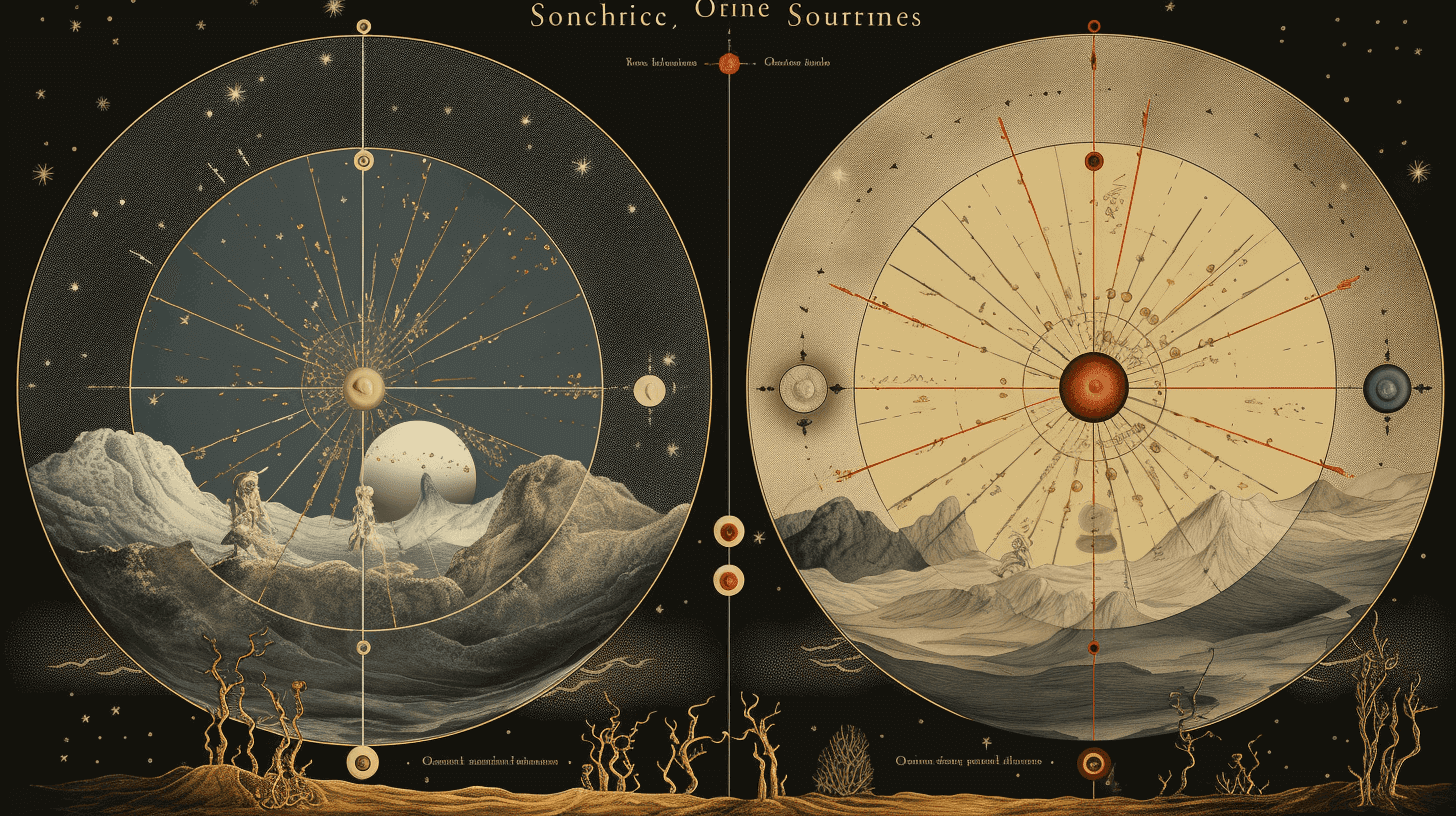Solstices and equinoxes are astronomical events that mark the changing seasons. They occur twice a year, with the solstices marking the longest and shortest days of the year, while equinoxes mark the two days where day and night are equal in length.
Understanding the Spiritual Significance of Solstices and Equinoxes
These events have been observed throughout human history and have held a significant place in various cultures around the world.
Definition of Solstices and Equinoxes
A solstice occurs when one of Earth’s poles has its maximum tilt towards or away from the sun. The summer solstice occurs around June 20-22 in the northern hemisphere, marking the longest day of the year, while winter solstice occurs around December 21-23, marking the shortest day of the year. On these days, sunlight hits either directly on or furthest away from one of Earth’s poles.
In contrast, an equinox is when day and night are nearly equal in length all over Earth – occurring twice a year around March 20-21 (spring equinox) and September 22-23 (fall equinox). During this time, neither pole is tilted towards or away from sunlight.
Brief History of their Significance in Different Cultures
Solstices and equinoxes have been celebrated in many cultures throughout history for their astronomical significance as well as their spiritual meaning. In ancient Egypt, for example, summer solstice was associated with rebirth as it marked flooding season for Nile River – which brought new life to crops.
Meanwhile winter solstice marked beginning of new era for Egyptians as it was aligned with Sirius star rising just before sunrise which would announce impending Nile floods.
In addition to ancient Egyptian culture there were also Celtic midsummer festivals that involved lighting bonfires and dancing during summer solstice. Similarly, Native American culture also paid homage to equinoxes by observing the change of seasons and honoring Earth’s bounty.
Importance of Understanding their Spiritual Significance
Understanding the spiritual significance of solstices and equinoxes can provide insight into the natural world, connecting us to our environment and its changes. This helps us to appreciate the universe’s cycles and acknowledge our place within it.
By observing these events, we can develop a deeper understanding of ourselves and how we fit into the larger scheme of things. Ultimately, this understanding can help us live more mindful lives in harmony with nature.
Solstices
Solstices mark the longest and shortest days of the year. They occur when the tilt of the Earth’s axis is either at its furthest point away from or closest to the sun, resulting in different amounts of sunlight depending on where you are on Earth. For centuries, solstices have been celebrated by various cultures around the world for their spiritual significance.
Summer Solstice: The Light Returns
The summer solstice occurs around June 20-22 in the Northern Hemisphere and marks the longest day of the year. In ancient cultures, this event was often seen as a time of renewal, as it signified the return of light and warmth after a long period of darkness.
Many religions have associated this day with various deities and celebrations such as Midsummer’s Eve. Today, many people view the summer solstice as an opportunity for spiritual growth and renewal.
It is often considered a time to celebrate nature and our connection to it, as we witness its abundance during this season. This can be done through practices such as meditation, nature walks or hikes, or simply spending time outdoors.
Rituals associated with summer solstice often involve lighting fires or candles to symbolize light returning to our lives after a period of darkness. Many people also gather with friends or family for feasts or celebrations during this time.
Winter Solstice: The Longest Night
The winter solstice occurs around December 21-23 in the Northern Hemisphere and marks the shortest day of the year. In ancient times, this event was often seen as a time to honor ancestors and look forward to new beginnings in springtime.
In modern times, many people still view winter solstice as an opportunity for reflection and introspection during what can be a dark and challenging season for some individuals.
It is often considered a time to focus on inner growth and spiritual renewal, as we prepare for the return of light in the coming months. Rituals associated with winter solstice often involve lighting candles to symbolize hope and renewal during a time of darkness.
Many people also practice gratitude by reflecting on their blessings or expressing thanks to loved ones. Some individuals also engage in group rituals or ceremonies that involve chanting, drumming or other forms of meditation.
Equinoxes
The equinoxes mark the two times of the year when day and night are of equal length, providing a unique opportunity to balance and harmonize our inner and outer worlds. In many ancient cultures, the equinoxes were celebrated as important turning points in the natural cycle of life.
For example, in ancient Egypt, the spring equinox marked the beginning of their new year, while in ancient China it was associated with agriculture and planting season.
Spring Equinox
The spring or vernal equinox marks the beginning of springtime in the Northern Hemisphere and autumn in the Southern Hemisphere. It is widely celebrated as a time of renewal, growth, and rebirth as nature begins to awaken from its winter slumber.
In pagan traditions, it is known as Ostara or Eostre after an Anglo-Saxon goddess of fertility. In modern times, many people view this equinox as an opportunity to set intentions for personal growth and transformation.
A common ritual involves creating a sacred space outdoors by gathering stones or flowers for an altar or by simply sitting quietly in nature. This can be followed by meditating on one’s intentions for new beginnings or by performing a cleansing ceremony such as smudging with sage.
Fall Equinox
The fall or autumnal equinox marks the transition from summer to winter in the Northern Hemisphere and from winter to summer in the Southern Hemisphere. In ancient cultures such as those of Greece and Rome, it was associated with harvest season and giving thanks for bountiful crops.
In modern times, this equinox is often viewed as a time for reflection on one’s blessings and gratitude for abundance both material and spiritual. Many people celebrate it through rituals such as making offerings to Mother Earth or creating altars with symbols representing harvest season like pumpkins or cornucopias.
Overall, both solstices and equinoxes provide an opportunity for us to connect with the rhythms of nature and find balance in our lives. By recognizing their spiritual significance and incorporating rituals or practices into our lives, we can deepen our connection to the natural world and foster personal growth and transformation.
The Connection Between Nature and Spirituality During Solstices and Equinoxes
The solstices and equinoxes have long been associated with nature, as they mark significant points in the earth’s seasonal cycles. These events offer a chance to reconnect with the natural world, which can be incredibly nourishing for our spiritual selves. By spending time in nature during these times, we can begin to feel more deeply connected to the universe.
How These Events Can Serve as a Reminder to Connect with Nature
In our fast-paced modern society, it’s easy to lose touch with nature. We spend much of our time indoors, staring at screens and disconnected from our surroundings. However, the solstices and equinoxes serve as a reminder that we are part of a greater ecosystem.
They encourage us to spend time outside in nature and pay attention to the world around us. By doing so, we can develop a deeper appreciation for all that nature has to offer.
How They Can Be Used as an Opportunity for Spiritual Growth
The solstices and equinoxes are also significant because they mark moments of transition between seasons. These transitions provide an opportunity for personal growth and transformation.
Just like the changing seasons in nature, we too go through periods of change in our lives. By reflecting on these changes during these events, we can gain insight into ourselves and our spiritual paths.
How They Can Help Us Align Our Energy with That of the Natural World
By spending time in nature during these events, we can align ourselves energetically with the natural world around us. The energy of the earth shifts during these times due to changes in light patterns and temperatures.
By attuning ourselves to this energy through meditation or other practices, we can align ourselves more fully with nature’s rhythms. This alignment is said to bring us into greater harmony with the universe and help us lead more fulfilling lives.
Recognizing the Significance of Solstices and Equinoxes
Understanding the spiritual significance of solstices and equinoxes can greatly enrich our lives. These events have been celebrated by cultures all over the world for thousands of years, and their symbolism still resonates with us today.
By recognizing these events as opportunities for spiritual growth, we can deepen our connection with nature and align our energy with that of the natural world.
Incorporating Rituals or Practices to Honor Solstices and Equinoxes
One way to honor solstices and equinoxes is by incorporating rituals or practices into our lives. This can include anything from meditation or prayer to lighting candles or performing a special dance. The key is to find something that resonates with you personally, and to make it a part of your regular routine.
By taking the time to acknowledge these events, we can tap into their transformative power and use them as a means for personal growth and self-discovery. Whether you choose to celebrate alone or with others, by honoring solstices and equinoxes you are connecting with an ancient tradition that has helped people throughout history find meaning in their lives.
Recognizing the spiritual significance of solstices and equinoxes can help us develop a deeper connection with nature, align our energy with that of the natural world, and provide opportunities for personal growth.
By incorporating rituals or practices into our lives to honor these events, we can tap into their transformative power and gain greater awareness of ourselves as part of a larger whole.




























































